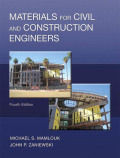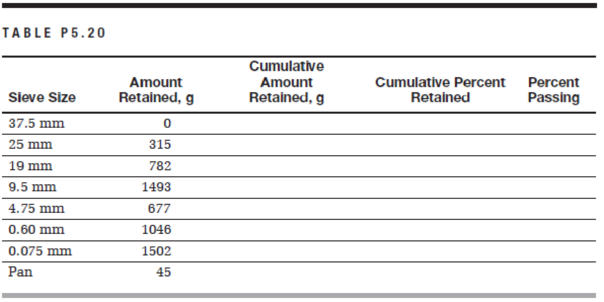
EBK MATERIALS FOR CIVIL AND CONSTRUCTIO
4th Edition
ISBN: 8220102719569
Author: ZANIEWSKI
Publisher: PEARSON
expand_more
expand_more
format_list_bulleted
Concept explainers
Textbook Question
thumb_up100%
Chapter 5, Problem 5.20QP
Calculate the sieve analysis shown in Table P5.20, and plot on a 0.45 power gradation chart. What is the maximum size? What is the nominal maximum size?

Expert Solution & Answer
Want to see the full answer?
Check out a sample textbook solution
Students have asked these similar questions
For the driven pile shown in figure, estimate the
allowable capacity by:
(a) Tomlinson a-method,
(b)Vijayvergia and Focht A-method.
Which one of the two methods are more conservative?
Qall =?
W.T
18.21 kN/m²
930
L=18m
Square pile
27.5cm x 27.5cm
What is the vertical deflection at joint C of the truss shown?
75 kN
9 m
7 (3000 mm²) (3000 mm²)
(2000
mm²)
(3000 mm²)
(2000 mm²)
100 kN
(3000 mm²)
H
(3000 mm²)
(2000 mm²)
(2000
mm²)
(3000 mm²)B(3000 mm²) C(3000 mm²)D(3000 mm2)5
a. 9.3 mm↓
b. 9.6 mm↓
c. 8.0 mm ↓
d. 9.1 mm↓
4 at 6 m = 24 m
E = 200 GPa
E
INVERSE FROM POINT A TOWARDS POINT B GIVEN THE FOLLOWINGCOORDINATE VALUES:
POINT AN=13,163,953.37'E=3,072,227.10'
POINT BN=13,163,463.03'E=3,072,129.30'
FIND THE FOLLOWING:DISTANCE FROM A TO BNORTH AZIMUTH (NAZ) FROM A TOWARDS BBEARING OF THE LINE FROM A TOWARDS B
Chapter 5 Solutions
EBK MATERIALS FOR CIVIL AND CONSTRUCTIO
Ch. 5 - Prob. 5.1QPCh. 5 - Discuss five different desirable characteristics...Ch. 5 - Discuss five different desirable characteristics...Ch. 5 - The shape and surface texture of aggregate...Ch. 5 - Define the following terms: a. Saturated...Ch. 5 - Three samples of fine aggregate have the...Ch. 5 - A sample of wet aggregate weighed 297.2 N. After...Ch. 5 - 46.5 kg (102.3 lb) of fine aggregate is mixed with...Ch. 5 - Samples of coarse aggregate from a stockpile are...Ch. 5 - Base course aggregate has a target dry density of...
Ch. 5 - Calculate the percent voids between aggregate...Ch. 5 - Calculate the percent voids between aggregate...Ch. 5 - Coarse aggregate is placed in a rigid bucket and...Ch. 5 - The following laboratory tests are performed on...Ch. 5 - Students in the materials lab performed the...Ch. 5 - The specific gravity and absorption test (ASTM...Ch. 5 - Prob. 5.18QPCh. 5 - Calculate the sieve analysis shown in Table P5.19...Ch. 5 - Calculate the sieve analysis shown in Table P5.20,...Ch. 5 - A sieve analysis test was performed on a sample of...Ch. 5 - A sieve analysis test was performed on a sample of...Ch. 5 - Draw a graph to show the cumulative percent...Ch. 5 - Referring to Table 5.6, plot the specification...Ch. 5 - Referring to the aggregate gradations A, B, and C...Ch. 5 - Table P5.26 shows the grain size distributions of...Ch. 5 - Table P5.27 shows the grain size distributions of...Ch. 5 - Three aggregates are to be mixed together in the...Ch. 5 - Table P5.29 shows the grain size distribution for...Ch. 5 - Laboratory specific gravity and absorption tests...Ch. 5 - Table P5.31 shows the grain size distribution for...Ch. 5 - Prob. 5.32QPCh. 5 - Laboratory specific gravity and absorption tests...Ch. 5 - Prob. 5.34QPCh. 5 - Define the fineness modulus of aggregate. What is...Ch. 5 - Calculate the fineness modulus of aggregate A in...Ch. 5 - Calculate the fineness modulus of aggregate B in...Ch. 5 - A portland cement concrete mix requires mixing...Ch. 5 - Discuss the effect of the amount of material...Ch. 5 - Aggregates from three sources having the...Ch. 5 - Aggregates from three sources having the...Ch. 5 - A contractor is considering using three stockpiles...Ch. 5 - Prob. 5.43QPCh. 5 - What are the typical deleterious substances in...Ch. 5 - Review ASTM D75 and summarize the following: a....
Additional Engineering Textbook Solutions
Find more solutions based on key concepts
How does a computers main memory differ from its auxiliary memory?
Java: An Introduction to Problem Solving and Programming (8th Edition)
Why is the study of database technology important?
Database Concepts (8th Edition)
17–1C A high-speed aircraft is cruising in still air. How does the temperature of air at the nose of the aircra...
Thermodynamics: An Engineering Approach
How are relationships between tables expressed in a relational database?
Modern Database Management
The solid steel shaft AC has a diameter of 25 mm and is supported by smooth bearings at D and E. It is coupled ...
Mechanics of Materials (10th Edition)
The following C++ program will not compile because the lines have been mixed up. cout Success\n; cout Success...
Starting Out with C++ from Control Structures to Objects (9th Edition)
Knowledge Booster
Learn more about
Need a deep-dive on the concept behind this application? Look no further. Learn more about this topic, civil-engineering and related others by exploring similar questions and additional content below.Similar questions
- FORWARD FROM POINT B TO POINT A GIVEN THE FOLLOWING: POINT BN=13,163,463.03'E=3,072,129.30' DIRECTION FROM B TO A (NAZ)=276.07529° DISTANCE FROM B TO A = 10.00'arrow_forwardA cheetah is crouched 20 m to the east of an observer. At time t = 0 s, the cheetah begins to run due east toward an antelope that is 50 m to the east of the observer. During the first 2.0 s of the attack, the cheetah's coordinate x varies with time according to the equation x = 20 + 5t?. (a) Find the cheetah's displacement between t1 = 1.0 s and t2 = 2.0 s. (b) Find its average velocity during that interval. (c) Derive an expression for the cheetah's instantaneous velocity as a function of time, and use it to find Vy at t = 1.0 s and t = 2.0 s.arrow_forwardWrite at least 20 words for vocabulary and 10 verbs .for simple present, past, and past participlesarrow_forward
- Can you compute the Panel Board Management while using the Lighting and Power Layout Plan as the base for it? The attached Panel Board Management picture is just an example. ps. not graded, I just want to know how to compute it based on a planarrow_forwardMake Sure the attached pic is correct, because the answer in mannings equation is wrong. Can you design a (Open Channel): -Most Efficient Section (Rectangular Shape) -Cost Estimate -Structural Analysis Design Requirements: Bed Slope= 1:1500 Manning's (n)= 0.015 Discharge: Q= 18 m^3/sarrow_forward2-7 The force P applied at joint D of the square frame causes the frame to sway and form the dashed rhombus. Determine the average normal strain developed in wire AC. Assume the three rods are rigid. I understand how you calculate length LAC its just the sqrt(400^2+400^2) = 565.685mm. I do understand that you have to take LAC'-LAC/LAC to get .0258mm/mm. I'm just not understanding the cosine law used to calculate LAC'. I guess what I'm asking is why do you use cos instead of sin or tangent? I've been trying to understand why that was used for a bit now and it's probably something simple I'm forgetting. If you can, please clarify it in detail. Thank you so much!arrow_forward
- Traffic flow on a three-lane (one direction) freeway can be described by the Greenshields model. One lane of the three lanes on a section of this freeway will have to be closed to undertake an emergency bridge repair that is expected to take 2 hours. It is estimated that the capacity at the work zone will be reduced by 30 percent of that of the section just upstream of the work zone. The mean free flow speed of the highway is 70 mi/h and the jam density is 150 veh/mi/In. If it is estimated that the demand flow on the highway during the emergency repairs is 85 percent of the capacity, using the deterministic approach, determine the following. (a) the maximum queue length (in veh) that will be formed veh (b) the total delay (in h) h (c) the number of vehicles that will be affected by the incident veh (d) the average individual delay (in min) minarrow_forwardNon-constant sections are used in bridges without changing the appearance of the bridge significantly. Refer to the figure below. Compute the ratio of moment inertial after to before of the plate girder shown (greater than 1). A 10x0.5" steel plate of the same grade as the plate girder and is fillet welded to the flangesarrow_forward8-18. Determine the vertical displacement of joint C if member CD is fabricated 10 mm too long. 4m D E B Carrow_forward
- 8-17. Determine the vertical displacement of joint C if members AB and BC experience a temperature increase of ST = 50°C. Take a = 12(10-6)/°C. A 4 m E 4 m 4 m B Darrow_forwardPlease solve all pointsarrow_forwardFor the I section prestressed concrete beam with a straight tendon shown in Fig below which is under the prestressing force, and U.D.L. Analyze the stresses at Mid- span at: A- transfer stage (due to initial prestress P. and self weight wo) B- at service stage. (due to effective prestress Pe and full loads) Check stresses with the ACI permissible stresses. Given: Initial prestress force Pi = 750 kN Effective prestress force Pe = 640 kN Wo (self) = 2.7 kN/m = W (D+L) 8 kN/m e = 130 mm I 5 10 mm² fci = 25 MPa (at transfer age), f' = 35 MPa (at service age) ASECTION 114 000 mm² W=4.75 kN/m |- 12 m F I 610mmarrow_forward
arrow_back_ios
SEE MORE QUESTIONS
arrow_forward_ios
Recommended textbooks for you
 Solid Waste EngineeringCivil EngineeringISBN:9781305635203Author:Worrell, William A.Publisher:Cengage Learning,
Solid Waste EngineeringCivil EngineeringISBN:9781305635203Author:Worrell, William A.Publisher:Cengage Learning, Steel Design (Activate Learning with these NEW ti...Civil EngineeringISBN:9781337094740Author:Segui, William T.Publisher:Cengage Learning
Steel Design (Activate Learning with these NEW ti...Civil EngineeringISBN:9781337094740Author:Segui, William T.Publisher:Cengage Learning Fundamentals Of Construction EstimatingCivil EngineeringISBN:9781337399395Author:Pratt, David J.Publisher:Cengage,
Fundamentals Of Construction EstimatingCivil EngineeringISBN:9781337399395Author:Pratt, David J.Publisher:Cengage, Fundamentals of Geotechnical Engineering (MindTap...Civil EngineeringISBN:9781305635180Author:Braja M. Das, Nagaratnam SivakuganPublisher:Cengage Learning
Fundamentals of Geotechnical Engineering (MindTap...Civil EngineeringISBN:9781305635180Author:Braja M. Das, Nagaratnam SivakuganPublisher:Cengage Learning Construction Materials, Methods and Techniques (M...Civil EngineeringISBN:9781305086272Author:William P. Spence, Eva KultermannPublisher:Cengage Learning
Construction Materials, Methods and Techniques (M...Civil EngineeringISBN:9781305086272Author:William P. Spence, Eva KultermannPublisher:Cengage Learning Materials Science And Engineering PropertiesCivil EngineeringISBN:9781111988609Author:Charles GilmorePublisher:Cengage Learning
Materials Science And Engineering PropertiesCivil EngineeringISBN:9781111988609Author:Charles GilmorePublisher:Cengage Learning

Solid Waste Engineering
Civil Engineering
ISBN:9781305635203
Author:Worrell, William A.
Publisher:Cengage Learning,

Steel Design (Activate Learning with these NEW ti...
Civil Engineering
ISBN:9781337094740
Author:Segui, William T.
Publisher:Cengage Learning

Fundamentals Of Construction Estimating
Civil Engineering
ISBN:9781337399395
Author:Pratt, David J.
Publisher:Cengage,

Fundamentals of Geotechnical Engineering (MindTap...
Civil Engineering
ISBN:9781305635180
Author:Braja M. Das, Nagaratnam Sivakugan
Publisher:Cengage Learning

Construction Materials, Methods and Techniques (M...
Civil Engineering
ISBN:9781305086272
Author:William P. Spence, Eva Kultermann
Publisher:Cengage Learning

Materials Science And Engineering Properties
Civil Engineering
ISBN:9781111988609
Author:Charles Gilmore
Publisher:Cengage Learning
What Is A Construction Takeoff? | Are They Still Necessary In Quantity Surveying?; Author: Metroun Quantity Surveying;https://www.youtube.com/watch?v=uTWoDPtcOjg;License: Standard Youtube License